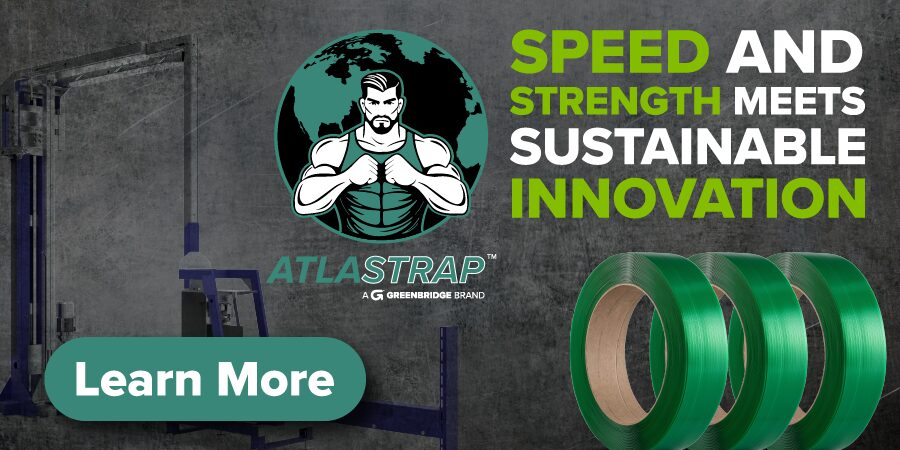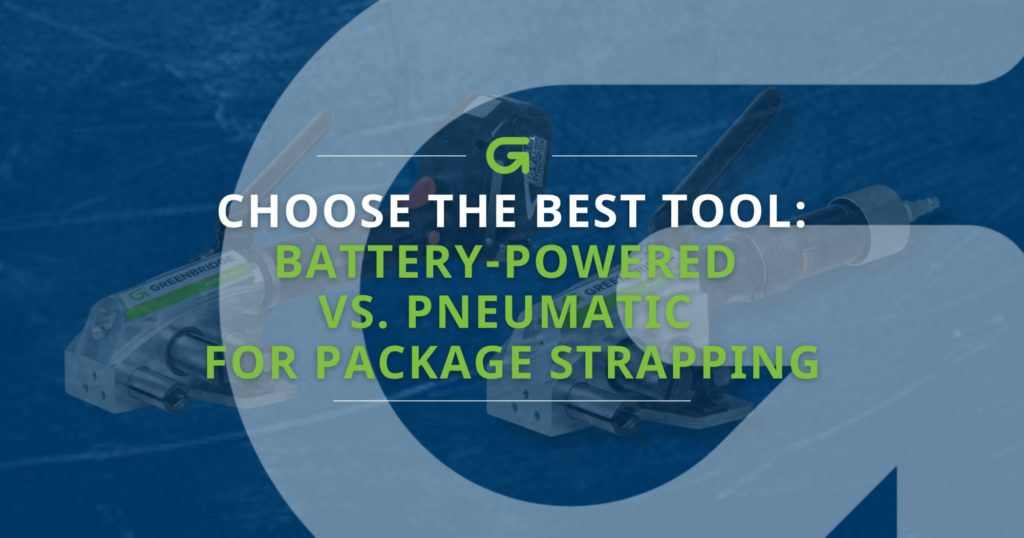

Choose the Best Tool: Battery-Powered vs. Pneumatic for Package Strapping

Greenbridge is your go-to source for a wide range of packaging solutions, including a diverse selection of battery and pneumatic tools for both plastic and steel strapping. Our tools are designed to meet the diverse needs of various industries, offering reliability, efficiency, and durability in every application.
At Greenbridge, we understand that choosing the right tool and strap is essential for optimizing your packaging processes. That’s why our sales, service, and customer service team members are here to guide you through the selection process. With their expertise and knowledge, they can help you determine the most suitable tool and strap combination for your specific industry and application requirements.
In this blog, we delve into the pros and cons of battery-powered versus pneumatic tools for package strapping. By exploring the benefits and considerations of each tool type, you’ll gain valuable insights to make informed decisions and enhance your packaging operations effectively. Let’s dive into the world of packaging tools and discover the best fit for your needs.
Battery-Powered Tools for Package Strapping
Battery-powered tools have become increasingly popular in the packaging industry due to their convenience and versatility. Let’s delve deeper into the advantages and disadvantages of using these tools:
Pros:
- Portability and Flexibility: One of the most significant advantages of battery-powered tools is their portability. They are not tethered to a power source, allowing workers to move freely and strap packages in various locations, including areas without easy access to electricity. This flexibility is particularly beneficial in warehouses or distribution centers where strapping needs to be done at different points.
- Ease of Use: Battery-powered tools are designed with user convenience in mind. They often feature ergonomic designs, lightweight construction, and intuitive controls, making them easy to handle and operate. This ease of use reduces operator fatigue and contributes to increased productivity.
- Versatility: These tools are versatile and compatible with a wide range of strapping materials, including polypropylene (PP) and polyester (PET) straps. They offer adjustable tension settings, allowing operators to customize the tension based on the package size and weight. This versatility makes battery-powered tools suitable for various packaging applications, from light-duty to heavy-duty strapping.
- Quiet Operation: Unlike pneumatic tools, which can be noisy during operation, battery-powered tools operate quietly. This is advantageous in environments where noise levels need to be kept to a minimum, such as retail stores or office settings. The reduced noise also contributes to a more comfortable working environment for operators.
Cons:
- Limited Battery Life: The primary drawback of battery-powered tools is their reliance on battery power, which leads to limited battery life. Depending on the model and usage intensity, batteries may need to be recharged frequently, leading to downtime during busy periods. However, advancements in battery technology have resulted in longer-lasting batteries with rapid charging capabilities, mitigating this issue to some extent.
- Initial Cost: Battery-powered tools generally have a higher upfront cost compared to pneumatic tools. This initial investment includes the cost of the tool itself, as well as spare batteries and charging equipment. However, the long-term benefits in terms of productivity gains and operational efficiency often justify the higher upfront cost.
- Maintenance Requirements: While battery-powered tools require less maintenance than pneumatic tools, they still require periodic battery replacements and maintenance checks to ensure optimal performance. Proper battery care, such as avoiding overcharging and storing batteries in a cool, dry place, is essential to prolong battery life and maintain consistent performance.
Pneumatic Tools for Package Strapping
Pneumatic tools have been a staple in the packaging industry for decades, offering reliable performance and high-speed strapping capabilities. Let’s examine the pros and cons of using pneumatic tools for package strapping:
Pros:
- High-Powered Performance: Pneumatic tools are renowned for their high-powered performance, making them ideal for heavy-duty strapping tasks. They can apply high levels of tension quickly and efficiently, ensuring secure and stable packaging. This high-performance capability is especially beneficial in industries such as manufacturing, logistics, and construction, where robust packaging is crucial for product protection during transit.
- Continuous Operation: Since pneumatic tools are powered by compressed air, they can operate continuously without the need for battery recharging. This continuous operation is advantageous in high-volume strapping environments, where downtime can significantly impact productivity. Pneumatic tools can handle large-scale strapping tasks with ease, making them suitable for industrial applications.
- Cost-Efficiency: In terms of initial cost, pneumatic tools are often more affordable than battery-powered tools. The cost of pneumatic tools includes the tool itself and the necessary air compressor equipment. While there is an initial investment in setting up the air compressor system, pneumatic tools have lower ongoing maintenance costs as they do not require battery replacements or charging infrastructure.
Cons:
- Dependency on Air Supply: The main drawback of pneumatic tools is their dependency on a compressed air supply. This limits their portability and requires access to an air compressor, which may not be feasible in all work environments. Additionally, fluctuations in air pressure or compressor malfunctions can affect the performance of pneumatic tools, leading to potential downtime.
- Noise Levels: Pneumatic tools can be loud during operation due to the air compressor’s noise and the tool’s mechanical components. This noise level can be a concern in noise-sensitive work areas or facilities where noise regulations are strict. Operators using pneumatic tools regularly should wear appropriate hearing protection to prevent hearing damage.
- Limited Adjustability: While pneumatic tools excel in heavy-duty strapping applications, they may have limited adjustability compared to battery-powered tools. Some pneumatic tools have fixed tension settings, which can be a drawback when working with a variety of package sizes and materials. Operators may need to use different tools or adjust the air pressure settings manually to accommodate different strapping requirements.
In conclusion, both battery-powered and pneumatic tools offer distinct advantages and disadvantages for package strapping applications. The choice between the two depends on factors such as portability requirements, budget considerations, operational needs, and the nature of strapping tasks. Ultimately, selecting the right tool ensures efficient and effective packaging processes, contributing to overall supply chain optimization and customer satisfaction.
Greenbridge can help. To purchase tools and accessories, visit our online store, or contact us to connect with your Regional Sales Manager.

